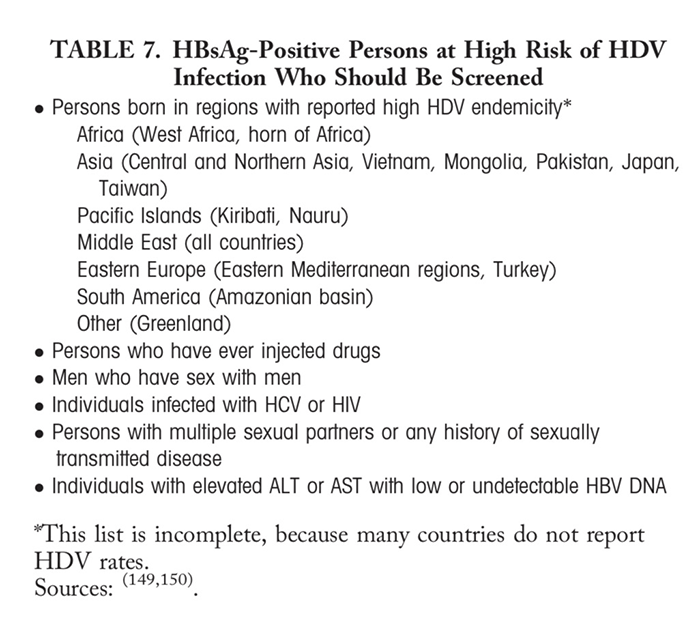| |
HEPATITIS D INFECTION: who should be screened AASLD 2018 HBV Guidelines
|
| |
| |
Download the PDF here
management, screening, who should be screened (IDUs, HIV+, HBV+, MSM, STD+, immigrants from countries HDV endemic)
AASLD Update on Prevention, Diagnosis, and Treatment of Chronic Hepatitis B: AASLD 2018 Hepatitis B Guidance
The AASLD 2016 HBV Guidelines recommend testing of HBsAg-positive persons at risk for HDV, including those with HIV infection, persons who inject drugs, men who have sex with men, and immigrants from areas of high HDV endemicity149, 150 (Table 7). Additionally, HBsAg-positive patients with low or undetectable HBV DNA but high ALT levels should be considered for HDV testing. Given the importance of HDV to the long-term management of the HBsAg-positive patient, if there is any uncertainty regarding the need to test, HDV screening is recommended. The recommended screening test is anti-HDV, and if this test result is positive, it should be followed by HDV-RNA testing to diagnose active HDV infection. A high degree of heterogeneity in sensitivity and specificity has been identified across HDV assays,151 and the availability of the first international external quality control for HDV quantification by the World Health Organization has led to improvements in HDV diagnostics.

The primary endpoint of treatment is the suppression of HDV replication, which is usually accompanied by normalization of ALT levels and a decrease in necroinflammatory activity on liver biopsy. For patients with elevated ALT levels, measurement of HBV DNA and HDV RNA will allow determination of the need for NA alone, peg-IFN alone, or combination therapy. The presence of underlying cirrhosis may further modify treatment decisions, as is the case in HBV monotherapy. Because NAs have no efficacy against HDV infection, they are not recommended in patients with suppressed or low HBV replication except patients with cirrhosis. HBV-DNA levels may change over time, including during treatment of HDV infection, and if the HBV-DNA levels become elevated, treatment with preferred NAs (entecavir, TDF, or TAF) is recommended. Long-term suppression of active HBV infection may be expected to reduce quantitative HBsAg levels, which should have a beneficial effect on HDV coinfection.
The only approved treatment of chronic hepatitis D is interferon alfa (IFN-α). Peg-IFN is the drug of choice without clear differences in efficacy between pegylated interferon alfa (peg-IFN-α)-2a (180 μg weekly) or -2b (1.5 μg/kg weekly).152 Treatment success, defined as undetectable HDV RNA 24 weeks after completing treatment, ranges from 23% to 57%.152-154 ALT normalization typically parallels the virological responses. The combination of NA with peg-IFN does not increase the likelihood of an off-treatment virological response.153 Late relapses can occur with longer follow-up, leading to very low rates of sustained HDV-RNA undetectability. In the multicenter HIDIT-1 (Hep-Net-International-Delta-Hepatitis-Intervention-Study 1) study of peg-IFN for 48 weeks with or without adefovir, 40% of patients achieved an undetectable HDV-RNA level 24 weeks after completing therapy,153 but at a mean follow-up 4.3 years later, only 12% remained undetectable.155 A complete virological response, defined as loss of HBsAg plus sustained suppression of HDV RNA, is a more desirable endpoint of therapy, but this occurs rarely with 1 year of treatment. Longer treatment duration may increase HBsAg loss, for example, peg-IFN for up to 5 years resulted in HBsAg loss in 3 of 13 patients (23%).156
An early virological response, defined by loss of HDV RNA after 24 weeks of treatment, was associated with a higher likelihood of a sustained off-treatment response, whereas a failure to achieve at least a 2-log copies/mL decline by this same time point was associated with a <5% chance of sustained off-treatment response.157 The benefits of peg-IFN on disease progression and clinical outcomes have been most closely associated with undetectability of HDV RNA during follow-up.
Given the poor response to current peg-IFN therapy, new drug therapies are urgently needed for HDV-infected persons. Phase 2 studies of prenylation inhibitors and entry inhibitors offer hope for new treatment options in the future.158, 159
Guidance Statements for Management of Patients With HDV Infection
1. Anti-HDV screening is recommended in HIV-positive persons, persons who inject drugs, men who have sex with men, those at risk for sexually transmitted diseases, and immigrants from areas of high HDV endemicity. Patients with low HBV-DNA levels and elevated ALT levels may be considered for HDV screening. If there is any uncertainty regarding the need to test, an initial anti-HDV test is recommended.
2. For those at risk for HDV acquisition, periodic retesting is recommended.
3. Anti-HDV–positive patients should have periodic assessment of HDV RNA and HBV DNA.
4. Peg-IFN-α for 12 months is the recommended therapy for those with elevated HDV-RNA levels and ALT elevation.
5. If HBV-DNA levels are elevated, concurrent therapy with NA using preferred drugs (entecavir, TDF, or TAF) is indicated.
6. Assessment of HDV-RNA is warranted if ALT elevation occurs following treatment because of the high rates of relapse.
7. Given the limited efficacy of current therapies, it is reasonable to refer patients to specialized centers that offer access to experimental therapies for HDV.
Gilead Submits Biologics License Application to U.S. Food and Drug Administration for Bulevirtide, an Investigational Treatment for People Living With Chronic Hepatitis Delta - (05/26/22)
AASLD: Strong intrahepatic decline of hepatitis D virus RNA and antigen after 48 weeks of treatment with Bulevirtide in chronic HBV/HDV co-infected patients: Interim results from a multicenter, open-label, randomized phase 3 clinical trial (MYR301) - (11/16/21)
AASLD: EFFICACY OF LONG-TERM TREATMENT OF CHRONIC HEPATITIS D PATIENTS WITH BULEVIRTIDE - RESULTS OF A "REAL WORLD" STUDY (11/23/21)
AASLD: Safety and Efficacy of 2 mg Bulevirtide in Patients with Chronic HBV/HDV Co-Infection: First Real-World Results - (11/17/21)
AASLD: ETHNIC VARIATIONS IN CLINICAL PRESENTATION AND TREATMENT ELIGIBILITY FOR HEPATITIS DELTA VIRUS INFECTION AT A US REFERRAL CENTER - (11/17/21)
|
|
| |
| |
|
|
|